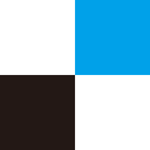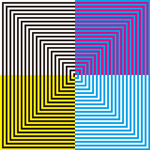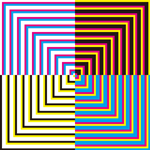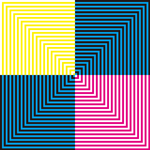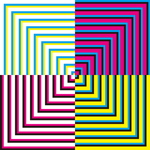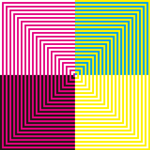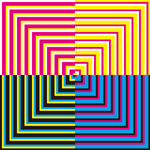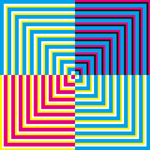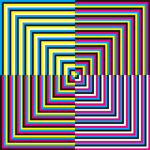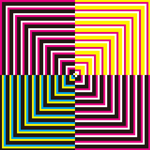CMYKによる四つの正方形の図案 Patterns of Four CMYK Quadrate
Sitemap
Language
- English
- 日本語
2009年 原案 2009, Original proposition
「CMYK」とは、「シアン」「マゼンタ」「イエロー」「キートーンブラック」の4種の色の配合から成る、印刷用に広く使われている色の表現法である。CMYKは減法混色として世界的に普及しており、印刷物の多くはCMYKによって出力される。 "CMYK" is a color model which consists of the four inks: cyan, magenta, yellow, and key tone(black), and often used in color printing. CMYK is in widespread use as a subtractive color model in the world, and a lot of things are printed with using CMYK.
ある1つの正方形の中に、4つの正方形を重ならないよう、かつ最大に描く。左上をa、右上をb、左下をc、右下をdとする。それぞれの色は、「なし(白)(0)」「シアン(1)」「マゼンタ(2)」「イエロー(3)」「キートーンブラック(4)」のいずれかである。 Draw four quadrates to maximize and eliminate overlap each other in one quadrate. Position: A part of upper left is "a," upper right is "b," left lower is "c," right lower is "d." Colors: none(white) is "0," cyan is "1," magenta is "2," yellow is "3," and key is "4."
4つの正方形はそれぞれ隣り合う2つの正方形と接する(例えば、bはaとdに、aはbとdに)。それぞれの正方形と、隣り合う2つの正方形の色の番号を確認し、3つの番号の和を求め、5で割ったときの余剰を求める。その余剰は、その正方形の中に描く小さい正方形の色の番号である(例えば、次のaの色は(a+b+c)/5の余剰)。4つの正方形は全てこの作業を行い、それぞれの中に元より小さい正方形を描く。描かれた4つの正方形はそれぞれの色の番号を確認し、次の更に小さい正方形の色の番号を決定する。この作業を繰り返し、ドットが1px以下になった場合に作業を終える。 Four each quadrates are adjoining to two quadrates (For example, "b" is adjoining to "a" and "d," "a" is adjoining to "b" and "d."). Next, add up one quadrate and its adjoining quadrates' color numbers(0 - 4), and calculate the remainder when the number divided by 5. The remainder number is the next color number of one smaller quadrate. For example, the next number of "a" is the reminder of (a+b+c)/5. And each four drawn quadrates deside calculating next color numbers of even smaller quadrates. Repeat this process until drawn quadrates are smaller than 1px.
例えば、a-0.b-0.c-2.d-0の場合、次の値はa-2.b-0.c-2.d-2、その次はa-4.b-4.c-1.d-4である(このページの一番左上のパターン)。各画像の副題としてのNo.*は、初期値をある一定のアルゴリズムで出力した際のソート順である(後述)。4桁の数字は、順にa、b、c、dの初期値としての色の番号である。 For instance, (a-0.b-0.c-2.d-0), next is (a-2.b-0.c-2.d-2), and farther next is (a-4.b-4.c-1.d-4) (this is the far upper left pattern in this page). "No.*" named for each images is the order by using the output algorithm (see later). Four figures are initial entry color numbers for a,b,c,d.
4つの正方形をこのアルゴリズムで描くとき、その順列はa、b、c、dの順に数えて5*5*5*5-1=5^4-1=624通りである。しかしこれらの中には、その線対称と点対称など、同じと見なすことができる初期値がいくつも重複している。例えば、1234と4321を考えると、 When four quadrates are drawn by this algorithm, there are 5*5*5*5-1=5^4-1=624 ways. However there are many duplicative initial entry numbers in this case: point-symmetric and line-symmetric. For example, "1234" and "4321" are drawn below:
1234(No.95) |
4321 |
であり、点対称である。aからdまで番号が異なるが、隣り合う色同士が同じであることがわかる。このウェブページではPCモニタの性質上、上下左右の表示とせざるを得ないが、この図案は実際には上下左右の概念は採用されない。上記の2つの図案は、同じと見なされる。よって、上下左右の重複を初期値から除き、隣り合う色同士が重複しない全初期値を考える必要がある。 Those are point-symmetric. Those are input different numbers each other, but adjacent colors are just all the same. Because those two patterns are the same, all initial entry numbers.
このアルゴリズムでの重複を除く全初期値の算出方法を記述する。まず、隣り合わない正方形同士の色を決定する。具体的には、aとdである。始めは番号を(a,d)=(0,0)とし、次にbを決定する。b=0とする。次にcを決定し、c=0~4まで5通りである。
I describe the algorithm that calculates all initial entry numbers without overlap. At first, decide each unadjacent quadrates' colors, in particular "a" and "d." Decide that "a" and "d" are 0, so those are described: (a,d)=(0,0). And next, decide the number of "b." Decide "b" is 0, so the number of "c" has 5 ways(0 - 4).
(a,b,c,d)=(0,0,0,0),(0,0,1,0),(0,0,2,0),(0,0,3,0),(0,0,4,0) *
0000 No.1 |
0010 No.2 |
0020 No.3 |
0030 No.4 |
0040 No.5 |
次に、b=1とすると、cは1~4となる。何故ならば、c=0とすれば、先に示した(a,b,c,d)=(0,0,1,0)と点対称になってしまうからだ。よって、下の表・図の4通りである。
Next, input 1 to "b," the number of "c" has 4 ways(1 - 4). Because, if "c" is 0, the pattern is the same as above "(a,b,c,d)=(0,0,1,0)" pattern because of a point-symmetry. So next patterns are drawn as four way below:
(a,b,c,d)=(0,1,1,0),(0,1,2,0),(0,1,3,0),(0,1,4,0)
0110 No.6 |
0120 No.7 |
0130 No.8 |
0140 No.9 |
b=2も同様に、c=2から始まる。先の重複を避けるためである。以下の3通りとなる。
In the same way, decide "b" is 2, so the number of "c" starts as 2 to avoid overlap. There are 3 ways below:
(a,b,c,d)=(0,2,2,0),(0,2,3,0),(0,2,4,0)
0220 No.10 |
0230 No.11 |
0240 No.12 |
続けて、b=3は以下になる。
When "b" is 3, there are 2 ways below:
(a,b,c,d)=(0,3,3,0),(0,3,4,0)
0330 No.13 |
0340 No.14 |
b=4は以下となる。 When "b" is 4, there is one way below: (a,b,c,d)=(0,4,4,0)
0440 No.15 |
これで(a,d)=(0,0)のパターンを全て挙げたことになる。つまり、対角にあたる側の色が0同士であるパターンを網羅した。 Here are all patterns of (a,d)=(0,0) above. In sum, there are all patterns on the condition that the numbers of opposing corners are 0.
以下同様の作業を行い、重複を避ける初期値を選出していく。以下のページは、全120通りの初期値をJavaScriptにて出力しているので、No.1~No.120の図案は、この初期値を基に出力し、ソートされている。 Doing the same calculation hereafter, find initial entry numbers. All 120 ways initial entry numbers are output by the JavaScript program in the following page, and No.1 - No.120 patterns are drawn based on those initial entry numbers.
『CMYKによる四つの正方形の図案』全初期値 All initial entry numbers of "Patterns of Four CMYK Quadrate"
* (a,b,c,d)=(0,0,0,0)は図案としては白紙であり、インクを落とす行為も「無い」が、計算上0000が「存在する」ので、No.1とする。実際の図案はNo.2~No.120の119パターンである。 * The pattern (a,b,c,d)=(0,0,0,0) is a blank (all white), and not be printed nothing. However this pattern is No.1 because of this calculation result: 0000. The practical patterns are 119 ways, from No.2 to No.120.
2009年2月1日(作成)、2009年4月1日(加筆) Preparation on February 1, 2009. Touch in on April 1, 2009.

